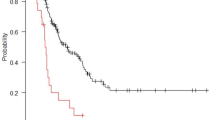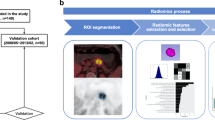Abstract
Purpose
We sought to develop and validate machine learning (ML) models for predicting tumor grade and prognosis using 2-[18F]fluoro-2-deoxy-D-glucose ([18F]FDG) positron emission tomography (PET)-based radiomics and clinical features in patients with pancreatic neuroendocrine tumors (PNETs).
Procedures
A total of 58 patients with PNETs who underwent pretherapeutic [18F]FDG PET/computed tomography (CT) were retrospectively enrolled. PET-based radiomics extracted from segmented tumor and clinical features were selected to develop prediction models by the least absolute shrinkage and selection operator feature selection method. The predictive performances of ML models using neural network (NN) and random forest algorithms were compared by the areas under the receiver operating characteristic curves (AUROCs) and validated by stratified five-fold cross validation.
Results
We developed two separate ML models for predicting high-grade tumors (Grade 3) and tumors with poor prognosis (disease progression within two years). The integrated models consisting of clinical and radiomic features with NN algorithm showed the best performances than the other models (stand-alone clinical or radiomics models). The performance metrics of the integrated model by NN algorithm were AUROC of 0.864 in the tumor grade prediction model and AUROC of 0.830 in the prognosis prediction model. In addition, AUROC of the integrated clinico-radiomics model with NN was significantly higher than that of tumor maximum standardized uptake model in predicting prognosis (P < 0.001).
Conclusions
Integration of clinical features and [18F]FDG PET-based radiomics using ML algorithms improved the prediction of high-grade PNET and poor prognosis in a non-invasive manner.





Similar content being viewed by others
Data Availability
The datasets of this study are available from the corresponding author upon reasonable request.
References
Parbhu SK, Adler DG (2016) Pancreatic neuroendocrine tumors: contemporary diagnosis and management. Hosp Pract 44:109–119
Chen J, Yang Y, Liu Y, Kan H (2021) Prognosis analysis of patients with pancreatic neuroendocrine tumors after surgical resection and the application of enucleation. World J Surg Oncol 19:11
Li G, Tian ML, Bing YT et al (2019) Clinicopathological features and prognosis factors for survival in elderly patients with pancreatic neuroendocrine tumor: A STROBE-compliant article. Medicine (Baltimore) 98:e14576
Tang LH, Untch BR, Reidy DL et al (2016) Well-Differentiated Neuroendocrine Tumors with a Morphologically Apparent High-Grade Component: A Pathway Distinct from Poorly Differentiated Neuroendocrine Carcinomas. Clin Cancer Res 22:1011–1017
Lee L, Ito T, Jensen RT (2019) Prognostic and predictive factors on overall survival and surgical outcomes in pancreatic neuroendocrine tumors: recent advances and controversies. Expert Rev Anticancer Ther 19:1029–1050
Fahmy JN, Varsanik MA, Hubbs D, Eguia E, Abood G, Knab LM (2021) Pancreatic neuroendocrine tumors: Surgical outcomes and survival analysis. Am J Surg 221:529–533
Di Leo M, Poliani L, Rahal D et al (2019) Pancreatic Neuroendocrine Tumours: The Role of Endoscopic Ultrasound Biopsy in Diagnosis and Grading Based on the WHO 2017 Classification. Dig Dis 37:325–333
Yang M, Zeng L, Ke NW et al (2020) World Health Organization grading classification for pancreatic neuroendocrine neoplasms: a comprehensive analysis from a large Chinese institution. BMC Cancer 20:906
Dai J, Wang H, Xu Y, Chen X, Tian R (2023) Clinical application of AI-based PET images in oncological patients. Semin Cancer Biol 91:124–142
Janssen BV, Verhoef S, Wesdorp NJ et al (2022) Imaging-based Machine-learning Models to Predict Clinical Outcomes and Identify Biomarkers in Pancreatic Cancer: A Scoping Review. Ann Surg 275:560–567
Ahmed TM, Kawamoto S, Hruban RH et al (2023) A primer on artificial intelligence in pancreatic imaging [published online ahead of print, 2023 Mar 24]. Diagn Interv Imaging. https://doi.org/10.1016/j.diii.2023.03.002
Nioche C, Orlhac F, Boughdad S et al (2018) LIFEx: A Freeware for Radiomic Feature Calculation in Multimodality Imaging to Accelerate Advances in the Characterization of Tumor Heterogeneity. Cancer Res 78:4786–4789
Zhang Z, Wei X (2023) Artificial intelligence-assisted selection and efficacy prediction of antineoplastic strategies for precision cancer therapy. Semin Cancer Biol 90:57–72
Luo J, Pan M, Mo K, Mao Y, Zou D (2023) Emerging role of artificial intelligence in diagnosis, classification and clinical management of glioma. Semin Cancer Biol 91:110–123
Ohki K, Igarashi T, Ashida H et al (2021) Usefulness of texture analysis for grading pancreatic neuroendocrine tumors on contrast-enhanced computed tomography and apparent diffusion coefficient maps. Jpn J Radiol 39:66–75
Li W, Xu C, Ye Z (2021) Prediction of Pancreatic Neuroendocrine Tumor Grading Risk Based on Quantitative Radiomic Analysis of MR. Front Oncol 11:758062
Bevilacqua A, Calabrò D, Malavasi S et al (2021) A [68Ga] Ga-DOTANOC PET/CT radiomic model for non-invasive prediction of tumour grade in pancreatic neuroendocrine tumours. Diagnostics (Basel) 11:870
Beleù A, Rizzo G, De Robertis R et al (2020) Liver tumor burden in pancreatic neuroendocrine tumors: CT features and texture analysis in the prediction of tumor grade and (18)F-FDG uptake. Cancers (Basel) 12:1486
Guo CG, Ren S, Chen X et al (2019) Pancreatic neuroendocrine tumor: prediction of the tumor grade using magnetic resonance imaging findings and texture analysis with 3-T magnetic resonance. Cancer Manag Res 11:1933–1944
Choi TW, Kim JH, Yu MH, Park SJ, Han JK (2018) Pancreatic neuroendocrine tumor: prediction of the tumor grade using CT findings and computerized texture analysis. Acta Radiol 59:383–392
Canellas R, Burk KS, Parakh A, Sahani DV (2018) Prediction of Pancreatic Neuroendocrine Tumor Grade Based on CT Features and Texture Analysis. AJR Am J Roentgenol 210:341–346
You Y, Jang JY, Kim SC et al (2019) Validation of the 8th AJCC Cancer Staging System for Pancreas Neuroendocrine Tumors Using Korean Nationwide Surgery Database. Cancer Res Treat 51:1639–1652
Gautam R, Peoples D, Jansen K et al (2020) Feature Selection and Rapid Characterization of Bloodstains on Different Substrates. Appl Spectrosc 74:1238–1251
Vabalas A, Gowen E, Poliakoff E, Casson AJ (2019) Machine learning algorithm validation with a limited sample size. PLoS One 14:e0224365
Qiu Q, Nian YJ, Guo Y et al (2019) Development and validation of three machine-learning models for predicting multiple organ failure in moderately severe and severe acute pancreatitis. BMC Gastroenterol 19:118
Hess LM, Brnabic A, Mason O, Lee P, Barker S (2019) Relationship between Progression-free Survival and Overall Survival in Randomized Clinical Trials of Targeted and Biologic Agents in Oncology. J Cancer 10:3717–3727
Bian Y, Jiang H, Ma C et al (2020) CT-Based Radiomics Score for Distinguishing Between Grade 1 and Grade 2 Nonfunctioning Pancreatic Neuroendocrine Tumors. AJR Am J Roentgenol 215:852–863
Park JE, Kim HS, Jo Y et al (2020) Radiomics prognostication model in glioblastoma using diffusion- and perfusion-weighted MRI. Sci Rep 10:4250
Takumi K, Fukukura Y, Higashi M et al (2015) Pancreatic neuroendocrine tumors: Correlation between the contrast-enhanced computed tomography features and the pathological tumor grade. Eur J Radiol 84:1436–1443
Guo C, Chen X, Xiao W, Wang Q, Sun K, Wang Z (2017) Pancreatic neuroendocrine neoplasms at magnetic resonance imaging: comparison between grade 3 and grade 1/2 tumors. Onco Targets Ther 10:1465–1474
Li G, Bing YT, Tian ML, Yuan CH, Xiu DR (2021) Using a Nomogram to Preoperatively Predict Distant Metastasis of Pancreatic Neuroendocrine Tumor in Elderly Patients. Chin Med Sci J 36:218–224
Shyr BS, Shyr BU, Chen SC, Shyr YM, Wang SE (2022) Impact of tumor grade on pancreatic neuroendocrine tumors. Asian J Surg 45:2659–2663
Gao Y, Gao H, Wang G et al (2018) A meta-analysis of Prognostic factor of Pancreatic neuroendocrine neoplasms. Sci Rep 8:7271
Özaslan E, Bayram F, Karaca H et al (2016) Best prognostic factor of neuroendocrine tumors: Grade or Stage? A multidisciplinary single-center study. Turk J Gastroenterol 27:509–514
Soczomski P, Jurecka-Lubieniecka B, Krzywon A et al (2021) A Direct Comparison of Patients With Hereditary and Sporadic Pancreatic Neuroendocrine Tumors: Evaluation of Clinical Course, Prognostic Factors and Genotype-Phenotype Correlations. Front Endocrinol (Lausanne) 12:681013
Benetatos N, Hodson J, Marudanayagam R et al (2018) Prognostic factors and survival after surgical resection of pancreatic neuroendocrine tumor with validation of established and modified staging systems. Hepatobiliary Pancreat Dis Int 17:169–175
Nanno Y, Toyama H, Otani K et al (2016) Microscopic venous invasion in patients with pancreatic neuroendocrine tumor as a potential predictor of postoperative recurrence. Pancreatology 16:882–887
Aysal A, Agalar C, Egeli T et al (2021) Reconsideration of Clinicopathologic Prognostic Factors in Pancreatic Neuroendocrine Tumors for Better Determination of Adverse Prognosis. Endocr Pathol 32:461–472
Yu H, Huang Z, Li M et al (2020) Differential Diagnosis of Nonhypervascular Pancreatic Neuroendocrine Neoplasms From Pancreatic Ductal Adenocarcinomas, Based on Computed Tomography Radiological Features and Texture Analysis. Acad Radiol 27:332–341
Wang Z, Chen X, Wang J, Cui W, Ren S, Wang Z (2020) Differentiating hypovascular pancreatic neuroendocrine tumors from pancreatic ductal adenocarcinoma based on CT texture analysis. Acta Radiol 61:595–604
Reinert CP, Baumgartner K, Hepp T, Bitzer M, Horger M (2020) Complementary role of computed tomography texture analysis for differentiation of pancreatic ductal adenocarcinoma from pancreatic neuroendocrine tumors in the portal-venous enhancement phase. Abdom Radiol (NY) 45:750–758
Lin X, Xu L, Wu A, Guo C, Chen X, Wang Z (2019) Differentiation of intrapancreatic accessory spleen from small hypervascular neuroendocrine tumor of the pancreas: textural analysis on contrast-enhanced computed tomography. Acta Radiol 60:553–560
D'Onofrio M, Ciaravino V, Cardobi N et al (2019) CT Enhancement and 3D Texture Analysis of Pancreatic Neuroendocrine Neoplasms. Sci Rep 9:2176
Li J, Lu J, Liang P et al (2018) Differentiation of atypical pancreatic neuroendocrine tumors from pancreatic ductal adenocarcinomas: Using whole-tumor CT texture analysis as quantitative biomarkers. Cancer Med 7:4924–4931
Song T, Zhang QW, Duan SF et al (2021) MRI-based radiomics approach for differentiation of hypovascular non-functional pancreatic neuroendocrine tumors and solid pseudopapillary neoplasms of the pancreas. BMC Med Imaging 21:36
Werner RA, Ilhan H, Lehner S et al (2019) Pre-therapy Somatostatin Receptor-Based Heterogeneity Predicts Overall Survival in Pancreatic Neuroendocrine Tumor Patients Undergoing Peptide Receptor Radionuclide Therapy. Mol Imaging Biol 21:582–590
Li C, Yin J (2021) Radiomics nomogram based on radiomics score from multiregional diffusion-weighted MRI and clinical factors for evaluating HER-2 2+ status of breast cancer. Diagnostics (Basel) 11:1491
Wu S, Wei Y, Li H et al (2022) A Predictive Clinical-Radiomics Nomogram for Differentiating Tuberculous Spondylitis from Pyogenic Spondylitis Using CT and Clinical Risk Factors. Infect Drug Resist 15:7327–7338
Rahman WT, Wale DJ, Viglianti BL et al (2019) The impact of infection and inflammation in oncologic (18)F-FDG PET/CT imaging. Biomed Pharmacother 117:109168
Takada T, Nijman S, Denaxas S et al (2021) Internal-external cross-validation helped to evaluate the generalizability of prediction models in large clustered datasets. J Clin Epidemiol 137:83–91
Funding
This work was supported by Basic Science Research Program through the National Research Foundation of Korea (NRF) funded by the Ministry of Science and ICT, Republic of Korea (NRF-2020R1C1C1011796) and Future Medicine 20*30 Project of the Samsung Medical Center (SMX1220101).
Author information
Authors and Affiliations
Contributions
Y.J.P. and H.S.H. conceptualized the study. H.S.H. was the project leader. Y.J.P., Y.S.P., S.T.K., and H.S.H. contributed to the data acquisition, analysis, and interpretation of the results. Y.J.P performed image analysis. Y.J.P and H.S.H. performed machine learning approach and statistical analysis. Y.J.P. drafted the manuscript, and prepared the tables and figures. All authors critically reviewed this manuscript and approved the manuscript before submission.
Corresponding author
Ethics declarations
Conflict of Interest
The authors have no conflicts of interest to declare.
Ethical Approval
All procedures performed in this study involving study patients were in accordance with the 1964 Helsinki declaration and its later amendments or comparable ethical standards and the ethical standards of the institutional and/or national research committee. This retrospective study was approved by the Institutional Review Board of Samsung Medical Center (registration number: 2022-07-121-001).
Informed Consent
In this retrospective study, formal consent is not required.
Additional information
Publisher’s Note
Springer Nature remains neutral with regard to jurisdictional claims in published maps and institutional affiliations.
Supplementary Information
ESM 1
(DOCX 45.4 KB)
Rights and permissions
Springer Nature or its licensor (e.g. a society or other partner) holds exclusive rights to this article under a publishing agreement with the author(s) or other rightsholder(s); author self-archiving of the accepted manuscript version of this article is solely governed by the terms of such publishing agreement and applicable law.
About this article
Cite this article
Park, YJ., Park, Y.S., Kim, S.T. et al. A Machine Learning Approach Using [18F]FDG PET-Based Radiomics for Prediction of Tumor Grade and Prognosis in Pancreatic Neuroendocrine Tumor. Mol Imaging Biol 25, 897–910 (2023). https://doi.org/10.1007/s11307-023-01832-7
Received:
Revised:
Accepted:
Published:
Issue Date:
DOI: https://doi.org/10.1007/s11307-023-01832-7




